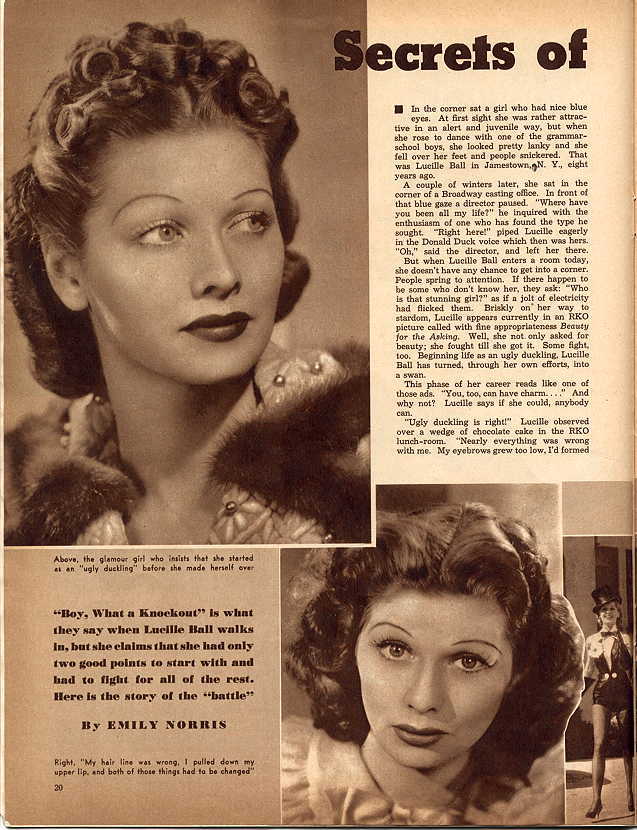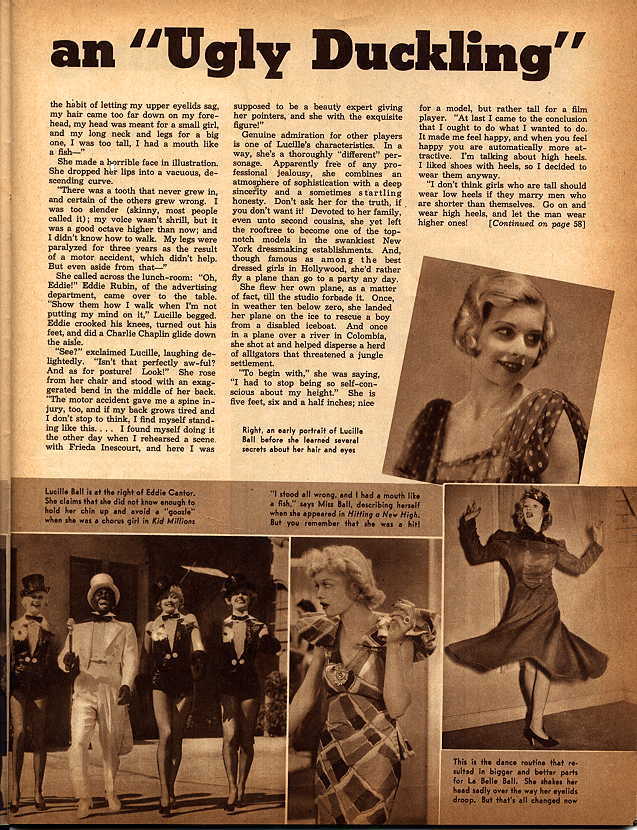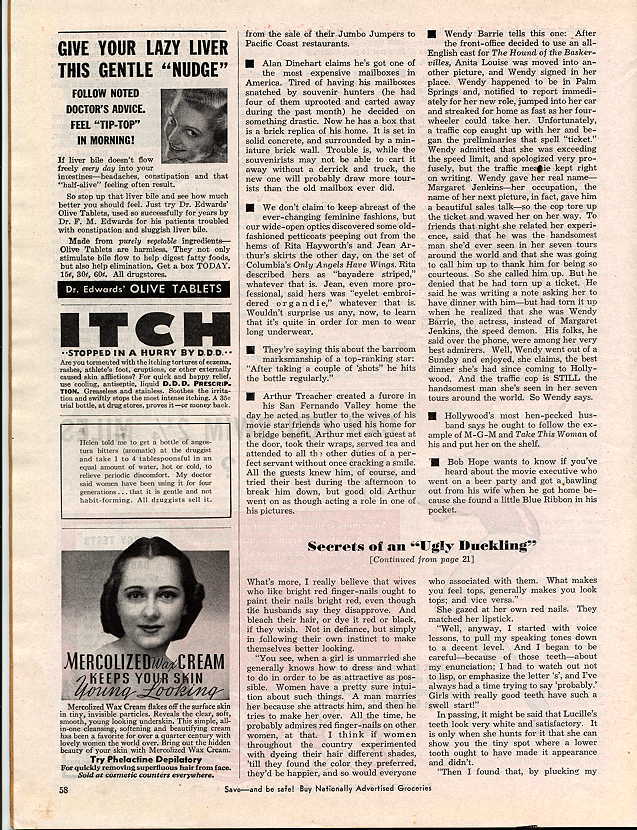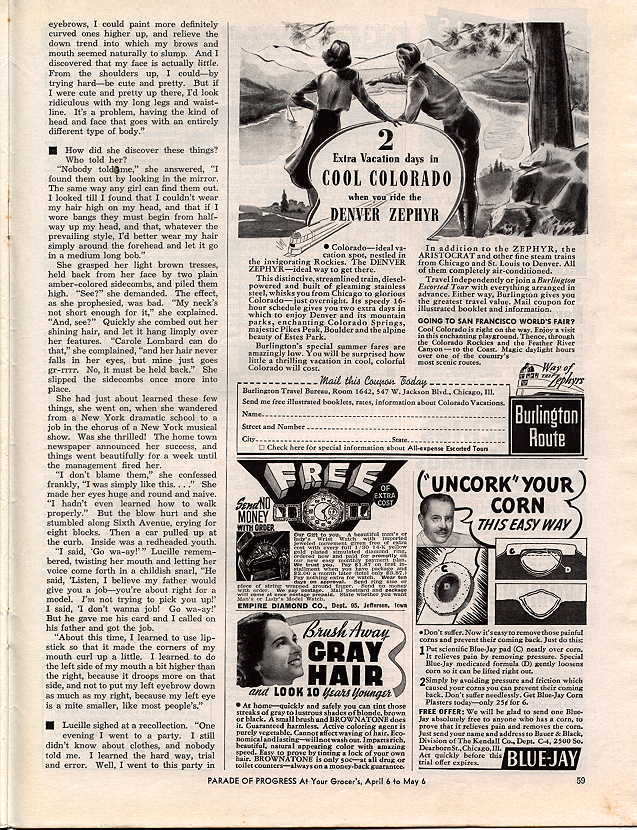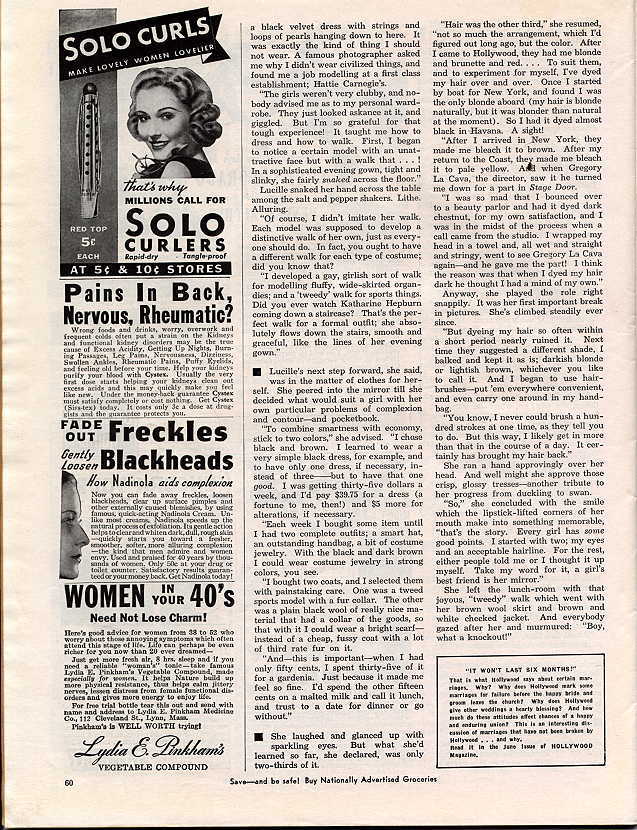|
Secrets of an "Ugly Duckling"
from Hollywood Screen Life magazine, May 1938 by Emily Norris they say when Lucille Ball walks in, but she claims that she had only two good points to start with and had to fight for all the rest. Here is the story of the "battle" In the corner sat a girl who had nice blue eyes. At first sight she was rather attractive in an alert and juvenile way, but when she rose to dance with one of the grammar-school boys, she looked pretty lanky and she fell over her feet and people snickered. That was Lucille Ball in Jamestown, N.Y., eight years ago. A couple of winters later, she sat in the corner of a Broadway casting office. In front of that blue gaze a director paused. "Where have you been all my life?" he inquired with the enthusiasm of one who has found the type he sought. "Right here!" piped Lucille eagerly in the Donald Duck voice which then was hers. "Oh," said the director, and left her there. But when Lucille Ball enters a room today, she doesn't have any chance to get into a corner. People spring to attention. If there happen to be some who don't know her, they ask: "Who is that stunning girl?" as if a jolt of electricity had flicked them. Briskly on her way to stardom, Lucille appears currently in an RKO picture called with fine appropriateness Beauty for the Asking. Well, she not only asked for beauty; she fought till she got it. Some fight, too. Beginning life as an ugly duckling, Lucille Ball has turned, through her own efforts, into a swan.  This phase of her career reads like one of those ads. "You, too, can have charm...." And why not? Lucille says if she could, anybody can. "Ugly duckling is right!" Lucille observed over a wedge of chocolate cake in the RKO lunch-room. "Nearly everything was wrong with me. My eyebrows grew too low, I'd formed the habit of letting my upper eyelids sag, my hair came too far down on my forehead, my head was meant for a small girl, and my long neck and legs for a big one, I was too tall, I had a mouth like a fish--" She made a horrible face in illustration. She dropped her lips into a vacuous, descending curve. "There was a tooth that never grew in, and certain of the others grew wrong. I was too slender (skinny, most people called it); my voice wasn't shrill, but it was a good octave higher than now; and I didn't know how to walk. My legs were paralyzed for three years as the result of a motor accident, which didn't help. But even aside from that--" She called across the lunch-room: "Oh, Eddie!" Eddie Rubin, of the advertising department, came over to the table. "Show them how I walk when I'm not putting my mind to it," Lucille begged. Eddie crooked his knees, turned out his feet, and did a Charlie Chaplin glide down the aisle. "See?" exclaimed Lucille, laughing delightedly. "Isn't that perfectly aw-ful? And as for posture! Look!" She rose from her chair and stood with an exaggerated bend in the middle of her back. "The motor accident gave me a spine injury, too, and if my back grows tired and I don't think, I find myself standing like this.... I found myself doing it the other day when I rehearsed a scene, with Frieda Inescourt, and here I was supposed to be a beauty expert giving her pointers, and she with the exquisite figure!"  Genuine admiration for other players is one of Lucille's characteristics. In a way, she's a thoroughly "different" personage. Apparently free of any professional jealousy, she combines an atmosphere of sophistication with a deep sincerity and a sometimes startling honesty. Don't ask her for the truth, if you don't want it! Devoted to her family, even unto second cousins, she yet left the rooftree to become one of the top-notch models in the swankiest New York dressmaking establishments. And, though famous as among the best dressed girls in Hollywood, she'd rather fly a plane than go to a party any day. Genuine admiration for other players is one of Lucille's characteristics. In a way, she's a thoroughly "different" personage. Apparently free of any professional jealousy, she combines an atmosphere of sophistication with a deep sincerity and a sometimes startling honesty. Don't ask her for the truth, if you don't want it! Devoted to her family, even unto second cousins, she yet left the rooftree to become one of the top-notch models in the swankiest New York dressmaking establishments. And, though famous as among the best dressed girls in Hollywood, she'd rather fly a plane than go to a party any day.She flew her own plane, as a matter of fact, till the studio forbade it. Once, in weather ten below zero, she landed her plane on the ice to rescue a boy from a disabled iceboat. And once in a plane over a river in Colombia, she shot at and helped disperse a herd of alligators that threatened a jungle settlement. "To begin with," she was saying, "I had to stop being so self-conscious about my height." She is five feet, six and a half inches; nice for a model, but rather tall for a film player. "At last I came to the conclusion that I ought to do what I wanted to. It made me feel happy, and when you feel happy you are automatically more attractive. I'm talking about high heels. I liked shoes with heels, so I decided to wear them anyway. "I don't think girls who are tall should wear low heels if they marry men who are shorter than themselves. Go on and wear high heels, and let the man wear higher ones! What's more, I really believe that wives who like bright red finger-nails ought to paint their nails bright red, even though the husbands say they disapprove. And bleach their hair, or dye it red or black, if they wish. Not in defiance, but simply in following their own instinct to make themselves better looking. "You see, when a girl is unmarried she generally knows how to dress and what to do in order to be as attractive as possible. Woman have a pretty sure intuition about such things. A man marries her because she attracts him, and then he tries to make her over. All the time, he probably admires red finger-nails on other woman, at that. I think if women throughout the country experimented with dyeing their hair different shades, till they found the color they preferred, they'd be happier, and so would everyone who was associated with them. What makes you feel tops, generally makes you look tops; and vice-versa." She gazed at her own red nails. They matched her lipstick.  "Well, anyway, I started with voice lessons, to pull my speaking tones down to a decent level. And I began to be careful--because of those teeth--about my enunciation; I had to watch out not to lisp, or emphasize the letter 's', and I've always had a time trying to say 'probably.' Girls with really good teeth have such a good start!" "Well, anyway, I started with voice lessons, to pull my speaking tones down to a decent level. And I began to be careful--because of those teeth--about my enunciation; I had to watch out not to lisp, or emphasize the letter 's', and I've always had a time trying to say 'probably.' Girls with really good teeth have such a good start!"In passing, it might be said that Lucille's teeth look very white and satisfactory. It is only when she hunts for it that she can show you the tiny spot where a lower tooth ought to have made it appearence and didn't. "Then I found out, by plucking my eyebrows, I could paint more definitley curved ones higher up, and relieve the down trend into which my brows and mouth seemed naturally to slump. And I discovered that my face is actually little. From the shoulders up, I could--by trying hard--be cute and pretty. But if I were cute and pretty up there, I'd look ridiculous with my long legs and waistline. It's a problem, having the kind of head and face that goes with an entirely different type of body." How did she discover these things? Who told her? "Nobody told me," she answered, "I found them out by looking in the mirror. The same way any girl can find them out. I looked till I found that I couldn't wear my hair high on my head, and that if I wore bangs they must begin from half-way up my head, and that, whatever the prevailing style, I'd better wear my hair simply around the forehead and let it go in a medium long bob." She grasped her light brown tresses, held back from her face by two plain amber-colored sidcombs, and piled them high. "See?" she demanded. The effect, as she prophesied, was bad. "My neck's not short enough for it," she explained. "And, see?" Quickly she combed out her shining hair, and let it hang limply over her features. "Carole Lombard can do that," she complained, "and her hair never falls in her eyes, but main just goes gr-rrrr. No, it must be held back." She slipped the sidecombs once more into place. She had just about learned these few things, she went on, when she wandered from a New York dramatic school to a job in the chorus of a New York musical show. Was she thrilled! The home town newspaper announced her success, and things went beautifully for a week until them management fired her. "I don't blame them," she confessed frankly, "I was simply like this...." She made her eyes huge and round and naive. "I hadn't even learned how to walk properly." But the blow hurt and she stumbled along Sixth Avenue, crying for eight blocks. Then a car pulled up at the curb. Inside was a redheaded youth. "I said, 'Go wa-ay!'" Lucille remembered, twisting her mouth and letting her voice come forth in a childish snarl, "He said, 'Listen, I believe my father would give you a job--you're about right for a model. I'm not trying to pick you up!' I said, 'I don't wanna job! Go wa-ay!' But he gave me his card and I called on his father and got the job. "About this time, I learned to use lipstick so that it made the corners of my mouth curl up a little. I learned to do the left side of my mouth a bit higher than the right, because it droops more on that side, and not to put my left eyebrow down as much to the right, because my left eye is a mite smaller, like most people's." Lucille sighed at a recollection. "One evening I went to a party. I still didn't know about clothes, and nobody told me. I learned the hard way, trial and error. Well, I went to this party in a black velvet dress with strings and loops of pearls hanging down to here. It was exactly the kind of thing I should not wear. A famous photographer asked me why I didn't wear civilized things, and found me a job modeling at a first class establishment; Hattie Carnegie's. "The girls weren't very chubby, and nobody advised me as to my personal wardrobe. They looked ascance at it, and giggled. But I'm so grateful for that tough experience! It taught me how to dress and how to walk. First, I began to notice a certain model with an unattractive face but with a walk that...! In a sophisticated evening gown, tight and slinky, she fairly snaked across the floor." Lucille snaked her hand across the table among the salt and pepper shakers. Lithe. Alluring.  "Of course, I didn't imitate her walk. Each model was supposed to develop a distinctive walk of her own, just as everyone should do. In fact, you ought to have a different walk for each type of costume; did you know that? "Of course, I didn't imitate her walk. Each model was supposed to develop a distinctive walk of her own, just as everyone should do. In fact, you ought to have a different walk for each type of costume; did you know that?"I developed a gay, girlish sort of walk for modeling fluffy, wide-skirted organdies; and a 'tweedy' walk for sports things. Did you ever watch Katharine Hepburn coming down a staircase? That's the perfect walk for a formal outfit; she absolutely flows down the stairs, smooth and graceful, like the lines of her evening gown." Lucille's next step forward, she said, was in the matter of clothes for herself. She peered into the mirror till she decided what would suit a girl with her own particular problems of complexion and contour--and pocketbook. "To combine smartness with economy, stick to two colors," she advised. "I chose black and brown. I learned to wear a very simple black dress, for example, and to have only one dress, if necessary, instead of three--but to have that one good. I was getting thirty-five dollars a week, and I'd pay $39.75 for a dress (a fortune for me, then!) and $5 more for alterations, if necessary. "Each week I bought some item until I had two complete outfits; a smart hat, an outstanding handbag, a bit of costume jewelry. With the black and dark brown I could wear costume jewelry in strong colors, you see. "I bought two coats, and I selected them with painstaking care. One was a tweed sports model with a fur collar. The other was a plain black wool of really nice material that had a collar of the goods, so that with it I could wear a bright scarf--instead of a cheap, fussy coat with a lot of third rate fur on it. "And--this is important--when I had only fifty cents, I spent thirty-five of it for a gardenia. Just because it made me feel so fine. I'd spend the other fifteen cents on a malted milk and call it lunch, and trust to a date for dinner or go without." She laughed and glanced up with sparkling eyes. But what she'd learned so far, she declared, was only two-thirds of it. "Hair was the other third," she resumed, "not so much the arrangement, which I'd figured out long ago, but the color. After I came to Hollywood, they had me blonde and brunette and red.... To suit them, and to experiment for myself, I've dyed my hair over and over. Once I started by boat for New York, and found I was the only blonde aboard (my hair is blonde naturally, but it was blonder than natural at the moment). So I had it dyed almost black in Havana. A sight! "After I arrived in New York, they made me bleach it brown. After my return to the Coast, they made me bleach it a pale yellow. And when Gregory La Cava, the director, saw it he turned me down for a part in Stage Door. "I was so mad that I bounced over to the beauty parlor and had it dyed dark chestnut, for my own satisfaction, and I was in the midst of the process when a call came from the studio. I wrapped me head in a towel and, all wet and straight and stringy, went to see Gregory La Cava again--and he gave me the part! I think the reason was that when I dyed my hair dark he thought I had a mind of my own." Anyway, she played the role right snappily. It was her first important break in pictures. She's climbed steadily ever since.  "But dyeing my hair so often within a short period nearly ruined it. Next time they suggested a different shade, I balked and kept it as is; darkish blonde or lightist brown, whatever you like to call it. And I began to use hairbrushes--put 'em everywhere convenient, and even carry one around in my handbag. "But dyeing my hair so often within a short period nearly ruined it. Next time they suggested a different shade, I balked and kept it as is; darkish blonde or lightist brown, whatever you like to call it. And I began to use hairbrushes--put 'em everywhere convenient, and even carry one around in my handbag."You know, I never could brush a hundred strokes at one time, as they tell you to do. But this way, I likely get in more than that in the course of a day. It certainly has brought my hair back." She ran a hand approvingly over her head. And well she might aprove those crisp, glossy tresses--another tribute to her process from duckling to swan. "So," she concluded with the smile which the lipstick-lifted corners of her mouth make into something memorable, "that's the story. Every girl has some good points. I started with two; my eyes and an acceptable hairline. For the rest, either people told me or I thought it up myself. Take my word for it, a girl's best friend is a mirror." She left the lunch-room with that joyous "tweedy" walk which went with her brown wool skirt and brown and white checked jacket. And everybody gazed after her and murmured: "Boy, what a knockout!"
Pages 20 (above, left) and 21 (right) from Hollywood Screen Life, May 1938
Pages 58 (left) and 59 (right) from Hollywood Screen Life, May 1938
Page 60 (left) and the back cover (right) from Hollywood Screen Life, May 1938 Magazine Rack | Main | swing4243@yahoo.com |
